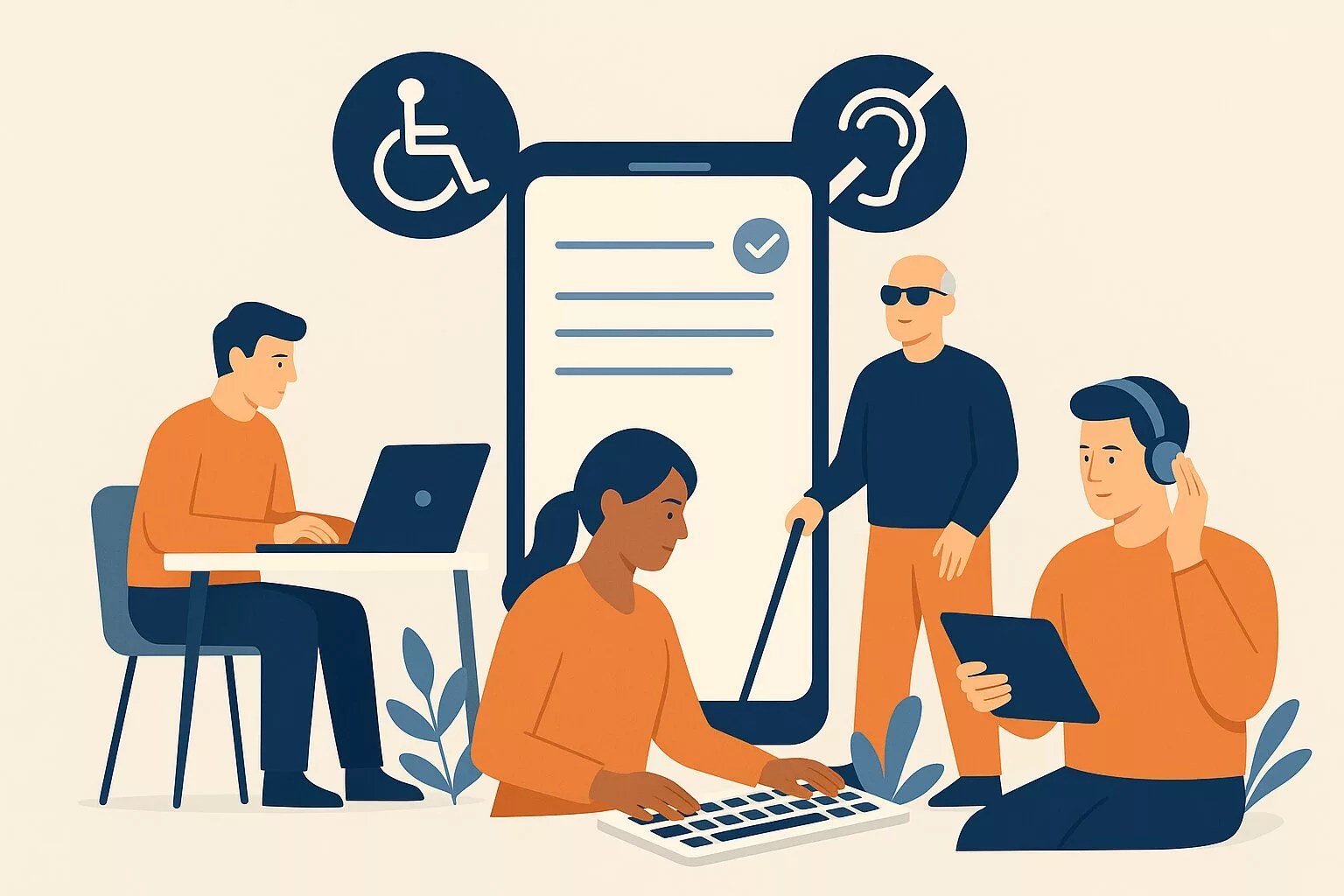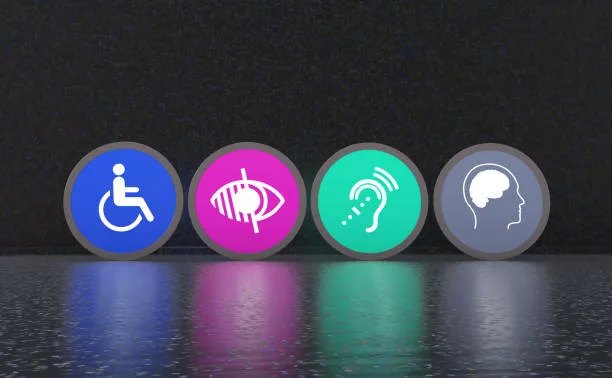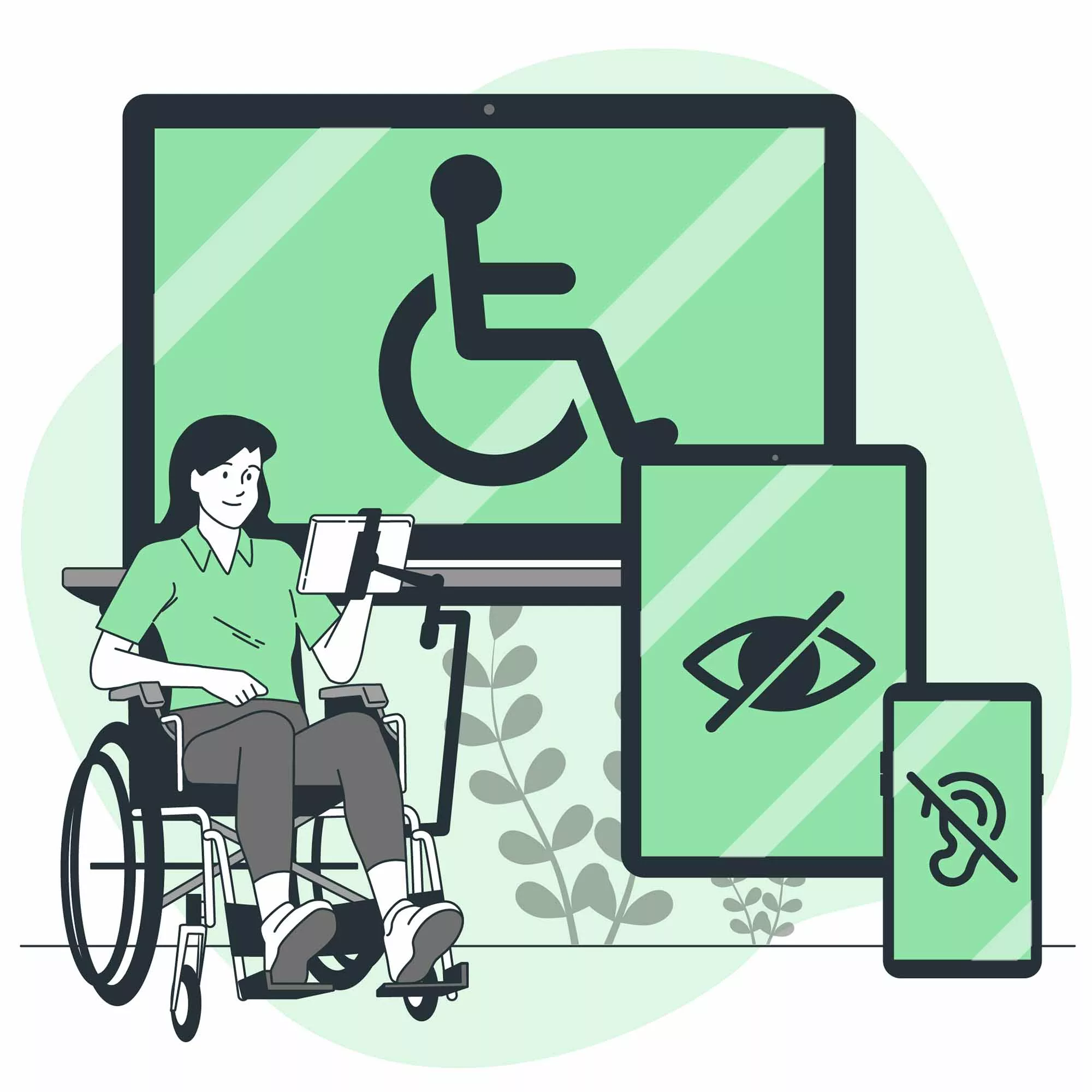Digital accessibility is a major issue in an increasingly connected world. As online technologies and services become ubiquitous, it is crucial that they are accessible to all, including people with disabilities. Digital accessibility aims to make websites, applications and digital content usable by a greater number of people, regardless of their physical, cognitive or sensory limitations. Let’s find out about the principles of digital accessibility, its importance, its challenges, and the standards and best practices for ensuring an inclusive online experience.
1. What is digital accessibility?
Digital accessibility refers to all practices aimed at making digital tools and content accessible to people of all abilities. This approach includes people with visual, hearing, motor or cognitive impairments, or any other form of disability.
Main areas of digital accessibility :
- Visual accessibility: Design interfaces accessible to the visually impaired, using high contrast, resizable text and keyboard navigation, for example.
- Auditory accessibility: Offer text alternatives to audio content (transcriptions, subtitles, etc.).
- Motor accessibility: Adapt interfaces for users with motor difficulties, enabling easy navigation with a keyboard or alternative devices.
- Cognitive accessibility: Simplify interfaces and make information clearer for people with cognitive impairments.
2. The importance of digital accessibility
The importance of digital accessibility is two fold:
- Social inclusion and equity: Ensuring access to digital information and services for people with disabilities, enabling them to participate actively in society, the economy and culture. This contributes to equal opportunities and inclusion.
- Legal compliance and liability: In many countries, laws and regulations require companies and public authorities to make their digital content accessible. In France, for example, the “Accessibilité numérique” law requires public services to make their sites compliant with accessibility criteria.
What’s more, digital accessibility enhances usability and user experience for all. Simple, well-structured, easy-to-navigate interfaces benefit all users, not just those with disabilities.
3. The economic challenges
- A wider market: According to the World Health Organization, around 15% of the world’s population lives with a disability. By making your digital products and services accessible, you open up access to this vast market, with potential consumers who are often under-exploited.
- Enhanced brand image: A digital accessibility policy strengthens a company’s reputation. By showing that you care about the needs of all your users, you foster loyalty and commitment.
- SEO optimization: Good accessibility practices, such as clear structuring of content, also improve search engine optimization (SEO), as they make content more comprehensible to search engines.
4. Norms and standards
There are several international standards for digital accessibility. The most widely used is the WCAG (Web Content Accessibility Guidelines), developed by the W3C (World Wide Web Consortium).
The main WCAG criteria :
- Perceptible: Information and interface components must be presented in such a way that they can be perceived by everyone. This includes adding alternative text to images, using contrasting colors, and providing subtitles for videos.
- Usable: Interfaces must be navigable and comprehensible to all. This means that interactive elements must be accessible via the keyboard, and that pages must be logically structured.
- Understandable: Information should be presented clearly and predictably, avoiding overly complex terms and using simple language.
- Solid: Digital content must be compatible with assistive technologies used by people with disabilities (screen readers, text-to-speech, etc.).
5. The challenges
Although digital accessibility is an essential objective, several challenges remain:
- Lack of awareness: Many web and application designers are not sufficiently trained or informed about accessibility issues. This leads to the creation of websites and applications with poor accessibility.
- Perceived cost: Some companies perceive the integration of digital accessibility as an additional burden, although the long-term benefits are obvious.
- Emerging technologies: Digital accessibility in new formats such as virtual reality (VR) or connected objects poses new challenges that require an innovative approach.
6. Best practices for making a site accessible
Here are a few best practices to follow to improve the digital accessibility of a site or application:
- Use sufficiently high color contrasts to ensure that text is legible, even for the visually impaired.
- Add alternative texts (
altattributes) for images and other visual elements. - Ensure keyboard navigation by allowing users to browse the site without a mouse.
- Structure pages with semantic HTML tags (titles, lists, etc.) to improve content readability and comprehension.
- Offer alternatives for audio and video content, such as subtitles and transcriptions.
- Test the site with disabled users, to identify and remedy obstacles.
7. Fines and penalties for non-compliant companies
In France, the law requires companies, particularly those with revenues in excess of €2 million, to comply with digital accessibility rules. Penalties for non-compliance can be severe.
Fines and legal consequences :
- Financial fine: Under the Digital Accessibility Act, a company that fails to comply with accessibility requirements can be fined up to 5,000 euros for individuals, and up to 15,000 euros for legal entities.
- Administrative sanctions: The authorities can impose coercive measures, such as injunctions to comply within a given timeframe.
- Tarnished reputation: In addition to financial penalties, companies risk tarnishing their reputation, which can damage user trust and their brand image.
- Non-compliance with public tenders: Companies that fail to comply with digital accessibility standards may be excluded from bidding on public tenders, particularly those issued by French public administrations, which require websites to comply with the law.
Example of a law: the 2016 “Digital Republic” law requires public and private websites that have an impact on access to public service (including companies with annual sales of over €2 million) to make their site accessible, on pain of penalties.
8. FreewayTeam: Your partner in the compliance process
FreewayTeam has positioned itself as a key expert and partner to help companies bring their websites into line with digital accessibility standards. FreewayTeam offers a range of tailored services to help companies comply with regulations, particularly those with sales in excess of 2 million euros.
The services offered by FreewayTeam include :
- Digital Accessibility Audit: Complete evaluation of your site to identify elements that do not comply with WCAG standards and legal requirements.
- Consulting and compliance strategy: Development of a customized action plan to make your digital content accessible, based on your company’s specific requirements.
- Team training and awareness: Training on digital accessibility for your technical and creative teams, so that they integrate accessibility right from the design stage of your digital projects.
- Development and implementation of accessible solutions: Assistance in integrating the best practices and functionalities needed to make your site or application compliant with accessibility standards.
With FreewayTeam‘s expertise, you can ensure that your company complies with digital accessibility legislation while delivering an optimal and inclusive user experience.
9. The future of digital accessibility
Digital accessibility is constantly evolving. New technologies, such as artificial intelligence, voice assistants and augmented reality, offer opportunities to create even more inclusive user experiences. However, they also raise new challenges to ensure that interfaces remain accessible to all.
Companies and institutions need to be proactive to anticipate technological developments and guarantee ongoing accessibility. “Accessibility by design” is the key to ensuring that tomorrow’s technologies are truly accessible to all.
Digital accessibility is a central issue for a more inclusive society. Not only does it offer social and economic benefits, it is also a legal requirement in many countries. By integrating accessibility into the design of your sites and applications, you contribute to the inclusion of disabled people and improve the experience for all users. As the digital world continues to evolve, accessibility must remain a priority, so that everyone can participate fully in the digital society.
With FreewayTeamyou have a reliable partner to help you navigate this process and ensure your digital platforms are compliant, while offering an inclusive and accessible experience.






